Geology 307: Igneous and Metamorphic Petrology (Spring 2015)
Item set
- Title
- Geology 307: Igneous and Metamorphic Petrology (Spring 2015)
- Creator
- Tamara Carley
- Date Created
- 22 January 2015
Items
-
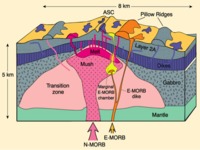 The tectonic settings for MORBs, OIBs and Convergent Margins are all very different. Magma that creates MORBs comes from the upper mantle. Since the upper mantle underneath a divergent boundary is responsible for producing so much magma, it is depleted in incompatible elements. Since MORBs are depleted in incompatible elements they are tholiitic. OIBs on the other hand, are created by mantle plumes that are sourced from the core-mantle boundary. Since the rocks at the core-mantle boundary are undepleted in incompatible elements, OIBs are rich in incompatible elements. This makes them rich in alkaline elements such as Na2O and K2O. Island arcs from convergent margins originate from subduction zones. As the slab subducts, water from hydrated minerals escapes from mineral structures. The water enters the surrounding mantle and lowers the melting temperature. Melt is then created and rises to the crust. Eventually this melt is erupted from the surface and forms volcanoes.
The tectonic settings for MORBs, OIBs and Convergent Margins are all very different. Magma that creates MORBs comes from the upper mantle. Since the upper mantle underneath a divergent boundary is responsible for producing so much magma, it is depleted in incompatible elements. Since MORBs are depleted in incompatible elements they are tholiitic. OIBs on the other hand, are created by mantle plumes that are sourced from the core-mantle boundary. Since the rocks at the core-mantle boundary are undepleted in incompatible elements, OIBs are rich in incompatible elements. This makes them rich in alkaline elements such as Na2O and K2O. Island arcs from convergent margins originate from subduction zones. As the slab subducts, water from hydrated minerals escapes from mineral structures. The water enters the surrounding mantle and lowers the melting temperature. Melt is then created and rises to the crust. Eventually this melt is erupted from the surface and forms volcanoes. -
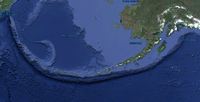 The Aleutian Arc is and island arc that formed and continues to grow as the result of volcanism produced by the subduction of one oceanic plate beneath another. This process of subduction occurs at convergent margins, and in the case of the Aleutian Arc the setting is one of oceanic plate convergence. This means two oceanic lithospheric plates collided and one began to subduct beneath the other because it was denser. At the Aleutian Arc the Pacific plate is subducting beneath the North American. Their collision is not perpendicular as the motion of the Pacific plate is north west at roughly 7 to 11 centimeters per year and the North American plate's motion is west of south west around 2.3 centimeters per year. The magmatic setting that result from the subduction of a hydrated oceanic lithospheric plate is one that involves melts forming in the mantle wedge between the overriding and subducting plate (Fig. 2). That melt then is free to rise through any overlying arc lithosphere and crust. There is may undergo any number of evolutionary processes which are discussed in the magma generation and geochemistry sections of this exhibit.
The Aleutian Arc is and island arc that formed and continues to grow as the result of volcanism produced by the subduction of one oceanic plate beneath another. This process of subduction occurs at convergent margins, and in the case of the Aleutian Arc the setting is one of oceanic plate convergence. This means two oceanic lithospheric plates collided and one began to subduct beneath the other because it was denser. At the Aleutian Arc the Pacific plate is subducting beneath the North American. Their collision is not perpendicular as the motion of the Pacific plate is north west at roughly 7 to 11 centimeters per year and the North American plate's motion is west of south west around 2.3 centimeters per year. The magmatic setting that result from the subduction of a hydrated oceanic lithospheric plate is one that involves melts forming in the mantle wedge between the overriding and subducting plate (Fig. 2). That melt then is free to rise through any overlying arc lithosphere and crust. There is may undergo any number of evolutionary processes which are discussed in the magma generation and geochemistry sections of this exhibit. -
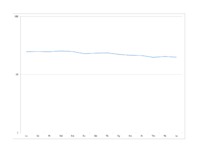 MORB geochemistry is characterized as being low in incompatible elements. This is because the mantle source rocks for the melt that creates the MORBs is low in incompatibles. In other words MORBs have depleted source rocks. As a result MORB REE diagrams are have a flat slope. MORB Harker diagrams share similar trends to Harker diagrams from other tectonic settings. MORB Harker diagrams correlated positively with Al2O3, K2O, and Na2O. They correlated negatively with TiO2, FeO, MgO, CaO and P2O5.
MORB geochemistry is characterized as being low in incompatible elements. This is because the mantle source rocks for the melt that creates the MORBs is low in incompatibles. In other words MORBs have depleted source rocks. As a result MORB REE diagrams are have a flat slope. MORB Harker diagrams share similar trends to Harker diagrams from other tectonic settings. MORB Harker diagrams correlated positively with Al2O3, K2O, and Na2O. They correlated negatively with TiO2, FeO, MgO, CaO and P2O5. -
Based on the geochemical data of both ocean settings, it is apparent that both are very similar in compositions. It is somewhat difficult to compare due to the small sample size of the Selvagen Island data. Both have very little alkaline content. This is due to the source of the magma. The REE diagrams are almost identical. This supports the interpretation that the source is the same. The incompatible levels are very similar, and they are higher than MORBs and CM. This indicates that ocean island magmas are not evolved and are considered fertile sourced. The landforms are also very similar. Both have almost exclusively shield volcanoes and various lava flows
-
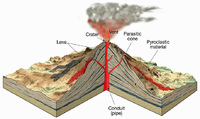 The staple volcanic landform at convergent margins is the composite or stratovolcano. Before these breach the surface they start as seamounts below sea level. As the arc matures the seamounts grow into volcanic islands as the result of continual melt generation from the dehydration of the subducting slab. This process is explained in the magma generation section of this exhibit. As the volcanic islands grow they may merge with neighboring ones to form larger land masses. Examples of well developed island arcs where this has occurred include Japan and New Zealand. The Aleutian Arc is moderately mature in the sense that is already has many stratovolcanoes that have formed islands and merged with others, but also has seamounts that are still below sea level towards the eastern portion of the fulll extent (Fig. 2). An example of a stratovolcano along the Aleutian Arc that is active at the moment is Mt. Cleveland.
The staple volcanic landform at convergent margins is the composite or stratovolcano. Before these breach the surface they start as seamounts below sea level. As the arc matures the seamounts grow into volcanic islands as the result of continual melt generation from the dehydration of the subducting slab. This process is explained in the magma generation section of this exhibit. As the volcanic islands grow they may merge with neighboring ones to form larger land masses. Examples of well developed island arcs where this has occurred include Japan and New Zealand. The Aleutian Arc is moderately mature in the sense that is already has many stratovolcanoes that have formed islands and merged with others, but also has seamounts that are still below sea level towards the eastern portion of the fulll extent (Fig. 2). An example of a stratovolcano along the Aleutian Arc that is active at the moment is Mt. Cleveland. -
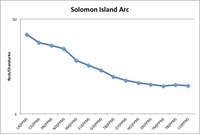 This visual describes my REE diagram for the incompatible elements within my location. They are compared to a sample of chondurite from the mantle. The slope of the diagram shows that overall the larger incompatible elements are more abundant within my sample compared to those within the chondurite sample. This is expected due to compatible elements fractionally crystallizing out of the melt and entire system, leaving just the compatible elements.
This visual describes my REE diagram for the incompatible elements within my location. They are compared to a sample of chondurite from the mantle. The slope of the diagram shows that overall the larger incompatible elements are more abundant within my sample compared to those within the chondurite sample. This is expected due to compatible elements fractionally crystallizing out of the melt and entire system, leaving just the compatible elements. -
Landforms - Though these margins are both convergent, they exhibit somewhat different landforms. The Cascades consist of many more stratovolcanoes, indicative of more siliceous magma and more viscous magma. This is due to the difference in the thicknesses of overlying continental lithosphere (thicker at the Cascades). Geochemistry - Referring to the Harker Diagrams for the Bismarck Arc - New Britain Chain and the Cascades, we see an immediate higher concentration of MgO series in the Bismarck Arc. This is possibly due to the fact that the Cascades sit further inland, allowing for the further evolution of a magmatic body. According to Alkali analysis, we see an agreement among the data that the margins exhibit a sub-alkaline series, however, the cascades have a higher alkali content than the Bismarck to New Britain Arc - likely due to the same reason listed above (higher amount of continental lithosphere incorporated into the melt). REE analysis of the convergent margins suggests that the Cascades have a higher concentration of incompatible elements relative to the Bismarck - New Britain Arc.
-
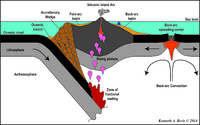 The melts produced subduction zones are sourced by the mantle wedge between the subducting and overriding lithospheric plates (Fig. 1). Under normal conditions melts do not form in the mantle (Fig. 2). The external invigoration that creates conditions conducive for partial melting of the mantle wedge is the introduction of water as a volatile into the system. Water lowers the melting point of the rocks and films of melt form around the crystals in the mantle wedge. Once enough melt has formed it begins to rise to lower pressures. As it rises it may assimilate surrounding rocks if it has enough thermal energy, volatile content, and the pressure and composition conditions of those rocks permit it. Once the melt reaches a certain point in the overlying arc it stalls as it encounters the room problem. This allows for more melt for rise into the system, the melting of the surrounding rock, which may be easier than the mantle source rocks due to increased incompatible content. The Aleutian Arc creates the staple melt of island arc settings, the calc-alkaline compositional series. This is despite the mantle source. Thus, the above mentioned evolutionary processes must have taken place to some degree. This is further investigated in the geochemistry section of this exhibit.
The melts produced subduction zones are sourced by the mantle wedge between the subducting and overriding lithospheric plates (Fig. 1). Under normal conditions melts do not form in the mantle (Fig. 2). The external invigoration that creates conditions conducive for partial melting of the mantle wedge is the introduction of water as a volatile into the system. Water lowers the melting point of the rocks and films of melt form around the crystals in the mantle wedge. Once enough melt has formed it begins to rise to lower pressures. As it rises it may assimilate surrounding rocks if it has enough thermal energy, volatile content, and the pressure and composition conditions of those rocks permit it. Once the melt reaches a certain point in the overlying arc it stalls as it encounters the room problem. This allows for more melt for rise into the system, the melting of the surrounding rock, which may be easier than the mantle source rocks due to increased incompatible content. The Aleutian Arc creates the staple melt of island arc settings, the calc-alkaline compositional series. This is despite the mantle source. Thus, the above mentioned evolutionary processes must have taken place to some degree. This is further investigated in the geochemistry section of this exhibit. -

-
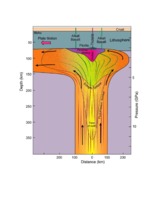 As with the physiography of the two localities the magma generation process does not differ much. The general mechanism of melting through continual thermal energy is the same. The difference lies in what kinds of melts occur at the different localities. This falls under the category of geochemistry. The two localities produce slightly different melts in a compositional sense. This may be due to differences in the thermal budgets of the two plumes. The Hawaiian plume may be hotter resulting more tholeiitic melts. The Samoan Islands are also closer to a subduction zone. This may affect the magma compositionally, but likely has little to no first degree effects on the processes that allow melt to form in the plume head. As the plume head stalls at the base of the lithosphere the conditions cross various mineral solidi allowing crystals to form films of melt around their rims (Fig. 1). Once enough melt fraction as formed it detaches from the source rock and begins rising as its own discernible magmatic system.
As with the physiography of the two localities the magma generation process does not differ much. The general mechanism of melting through continual thermal energy is the same. The difference lies in what kinds of melts occur at the different localities. This falls under the category of geochemistry. The two localities produce slightly different melts in a compositional sense. This may be due to differences in the thermal budgets of the two plumes. The Hawaiian plume may be hotter resulting more tholeiitic melts. The Samoan Islands are also closer to a subduction zone. This may affect the magma compositionally, but likely has little to no first degree effects on the processes that allow melt to form in the plume head. As the plume head stalls at the base of the lithosphere the conditions cross various mineral solidi allowing crystals to form films of melt around their rims (Fig. 1). Once enough melt fraction as formed it detaches from the source rock and begins rising as its own discernible magmatic system. -
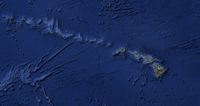 Both localities have the same general landform features. The islands are shield volcanoes that grew as the result of low viscosity lava flows being layered upon each other while the landform was above sea level. As the islands are moved off of the hotspot vent and the lithospheric bulge caused by melt production they eventually subside below sea level. This takes variable lengths of time depending on how much growth occurred when the landform was a shield volcano at the surface. The degree of weathering and rate of plate motion also affects the physiography of the landforms. Once the islands are submerged they are not susceptible to weathering and are traceable on topographic maps of the ocean floor. The Hawaiian Islands are a type example of this aspect of mantle plume surface physiography. The direction and rate of plate motion is preserved in the path of extinct ocean islands.
Both localities have the same general landform features. The islands are shield volcanoes that grew as the result of low viscosity lava flows being layered upon each other while the landform was above sea level. As the islands are moved off of the hotspot vent and the lithospheric bulge caused by melt production they eventually subside below sea level. This takes variable lengths of time depending on how much growth occurred when the landform was a shield volcano at the surface. The degree of weathering and rate of plate motion also affects the physiography of the landforms. Once the islands are submerged they are not susceptible to weathering and are traceable on topographic maps of the ocean floor. The Hawaiian Islands are a type example of this aspect of mantle plume surface physiography. The direction and rate of plate motion is preserved in the path of extinct ocean islands. -
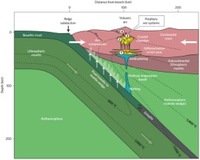
-
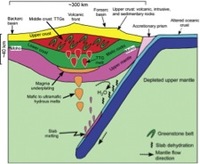
-
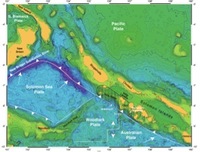
-
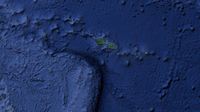 When it comes to the tectonic magmatic setting of these two localities there is not much to compare beyond the physical location on the lithsopheric plate. They are both situated on the Pacific plate. The Hawaiian Islands are north of the equator and east of the international date line. The Samoan Islands are just south of the equator and just east of the international date line. They are both examples of mantle plumes manifesting themselves on the surface as shield volcano islands. The Samoan Islands are however approaching the Mariana Trench which may have geochemical or physiographical implications.
When it comes to the tectonic magmatic setting of these two localities there is not much to compare beyond the physical location on the lithsopheric plate. They are both situated on the Pacific plate. The Hawaiian Islands are north of the equator and east of the international date line. The Samoan Islands are just south of the equator and just east of the international date line. They are both examples of mantle plumes manifesting themselves on the surface as shield volcano islands. The Samoan Islands are however approaching the Mariana Trench which may have geochemical or physiographical implications. -
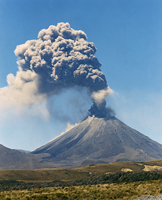 The landforms in both convergent setting have composite and strato volcanoes. The Aleutian Arc is less developed and less evolved of an arc, so there are smaller, less diverse volcanoes in the Aleutian Arc when compared to New Zealand. The New Zealand arc has much more material which has caused the volcanic islands to form together into two larger islands, allowing for even more of a diverse magma to reach the surface and cause larger, more explosive stratovolcanoes.
The landforms in both convergent setting have composite and strato volcanoes. The Aleutian Arc is less developed and less evolved of an arc, so there are smaller, less diverse volcanoes in the Aleutian Arc when compared to New Zealand. The New Zealand arc has much more material which has caused the volcanic islands to form together into two larger islands, allowing for even more of a diverse magma to reach the surface and cause larger, more explosive stratovolcanoes. -
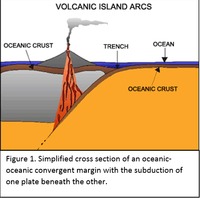 For these two areas, the tectonic setting and magma generating processes are the same. In both areas, the oceanic-oceanic convergent system is the setting. There is one oceanic plate subducting under the other. In both situations, the main driving force for the melt is the addition of volatiles into the system from the subducting slab.
For these two areas, the tectonic setting and magma generating processes are the same. In both areas, the oceanic-oceanic convergent system is the setting. There is one oceanic plate subducting under the other. In both situations, the main driving force for the melt is the addition of volatiles into the system from the subducting slab. -
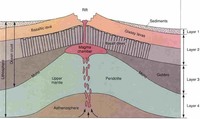 MORBs are generated at Mid-Ocean Ridge divergent margins. Decompression melting dominates this region. MORBs are sub-alkaline and tholeiitic in composition, with depleted sources which undergo some alteration. OIBs are formed on intraplate hotspot islands. Melting occurs in this area because of a rise in temperature at constant pressure. OIBs have an alkaline composition. Convergent Margins are when two plates converge and one subducts. The subducting plate releases volatiles into the mantle system, allowing melt to occur. Rocks sourced from convergent margins are sub-alkaline and calc-alkaline in composition, with an overall evolved, diverse melt source.
MORBs are generated at Mid-Ocean Ridge divergent margins. Decompression melting dominates this region. MORBs are sub-alkaline and tholeiitic in composition, with depleted sources which undergo some alteration. OIBs are formed on intraplate hotspot islands. Melting occurs in this area because of a rise in temperature at constant pressure. OIBs have an alkaline composition. Convergent Margins are when two plates converge and one subducts. The subducting plate releases volatiles into the mantle system, allowing melt to occur. Rocks sourced from convergent margins are sub-alkaline and calc-alkaline in composition, with an overall evolved, diverse melt source. -
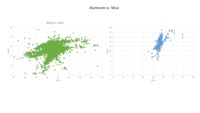 The geochemical data from GeoRoc for the Hawaiian Islands and the Samoan Islands were used to create plots that reflect compositional trends in the data. For major elements such as Fe, Mg, Ca, Na, K, and Al the trends appear to have the same general habit. The Hawaiian Islands data set contains for far more data points compared to the Samoan Islands data set. This leaves the trend not as easily visible in the Samoan Islands plots (blue data) compared to the Hawaiian Islands plots (green data). Different trends are visible when comparing the alkaline content of the two locales. The Samoan Islands appear to favor alkaline compositions, whereas the Hawaiian Islands, although spread across both alkaline and sub-alkaline, appear to favor the latter (pdf 8). This disparity is further investigated in the plots denominating tholeiitic and calc-alkaline (pdf. 9). The Hawaiian Islands plot indicates the compositions are spread across both compositions. The Samoan Islands are almost exclusively tholeiitic. The levels of aluminum saturation at both settings appear to be very similar, but for a lack of similar size data sets. Thus, the Samoan Islands have a smaller range of aluminum saturation (pdf. 10). The alkali, iron, magnesium ternary diagrams for both settings (pdf. 11) indicate that both settings had melt evolution. The Hawaiian Islands ternary diagram (on the left) shows compositions including calc-alkaline and the Samoan Islands (to the right) shows more tholeiitic heavy compositions. The MORB normalized trace element trends are relatively similar to one another indicating that relative to a depleted mid ocean ridge both settings are similarly concentrated in incompatible trace elements.
The geochemical data from GeoRoc for the Hawaiian Islands and the Samoan Islands were used to create plots that reflect compositional trends in the data. For major elements such as Fe, Mg, Ca, Na, K, and Al the trends appear to have the same general habit. The Hawaiian Islands data set contains for far more data points compared to the Samoan Islands data set. This leaves the trend not as easily visible in the Samoan Islands plots (blue data) compared to the Hawaiian Islands plots (green data). Different trends are visible when comparing the alkaline content of the two locales. The Samoan Islands appear to favor alkaline compositions, whereas the Hawaiian Islands, although spread across both alkaline and sub-alkaline, appear to favor the latter (pdf 8). This disparity is further investigated in the plots denominating tholeiitic and calc-alkaline (pdf. 9). The Hawaiian Islands plot indicates the compositions are spread across both compositions. The Samoan Islands are almost exclusively tholeiitic. The levels of aluminum saturation at both settings appear to be very similar, but for a lack of similar size data sets. Thus, the Samoan Islands have a smaller range of aluminum saturation (pdf. 10). The alkali, iron, magnesium ternary diagrams for both settings (pdf. 11) indicate that both settings had melt evolution. The Hawaiian Islands ternary diagram (on the left) shows compositions including calc-alkaline and the Samoan Islands (to the right) shows more tholeiitic heavy compositions. The MORB normalized trace element trends are relatively similar to one another indicating that relative to a depleted mid ocean ridge both settings are similarly concentrated in incompatible trace elements. -
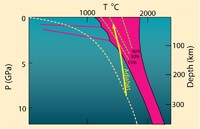 These files illustrate the process of magma generation at a mid ocean ridge.
These files illustrate the process of magma generation at a mid ocean ridge. -
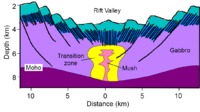 The rate of spreading at a Mid-Ocean Ridge greatly affects the landscape of the area. The attached files show some of the features of a slow-spreading ridge (>3 cm/year)
The rate of spreading at a Mid-Ocean Ridge greatly affects the landscape of the area. The attached files show some of the features of a slow-spreading ridge (>3 cm/year) -
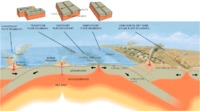 A comparative look at the landforms, magma settings, and the geochemistry of different tectonic settings
A comparative look at the landforms, magma settings, and the geochemistry of different tectonic settings -
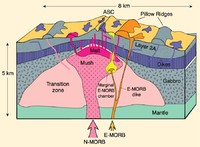 The geometry of a Mid-Ocean Ridge varies significantly if it is a fast-spreading (3 cm/year) The attached files illustrate the features of a fast-spreading ridge
The geometry of a Mid-Ocean Ridge varies significantly if it is a fast-spreading (3 cm/year) The attached files illustrate the features of a fast-spreading ridge -
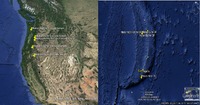 A comparative look at the landforms, magma settings, and the geochemistry of two convergent margins.
A comparative look at the landforms, magma settings, and the geochemistry of two convergent margins.
